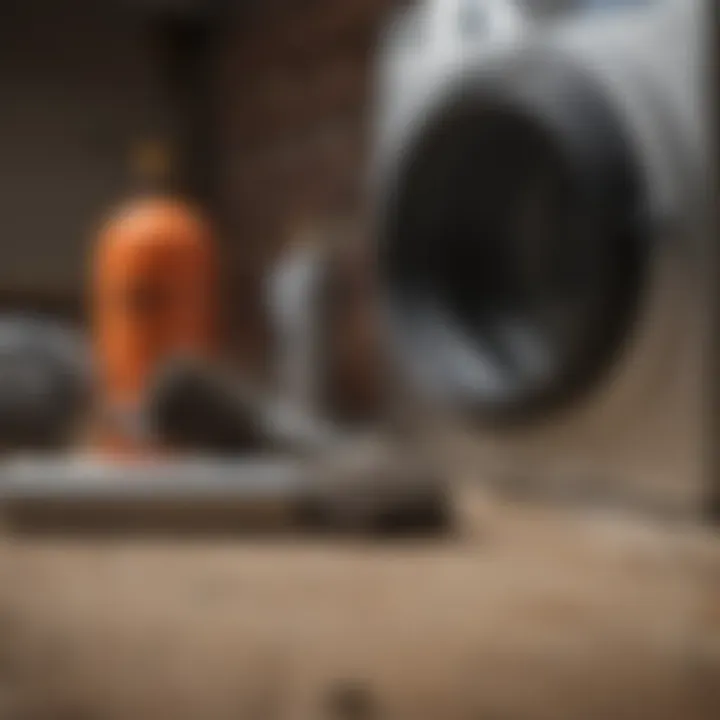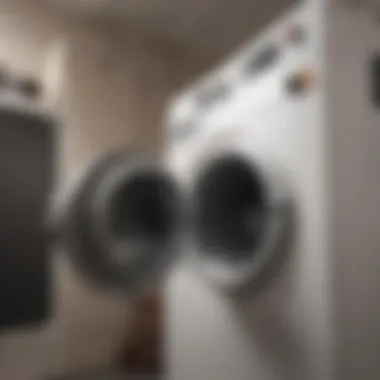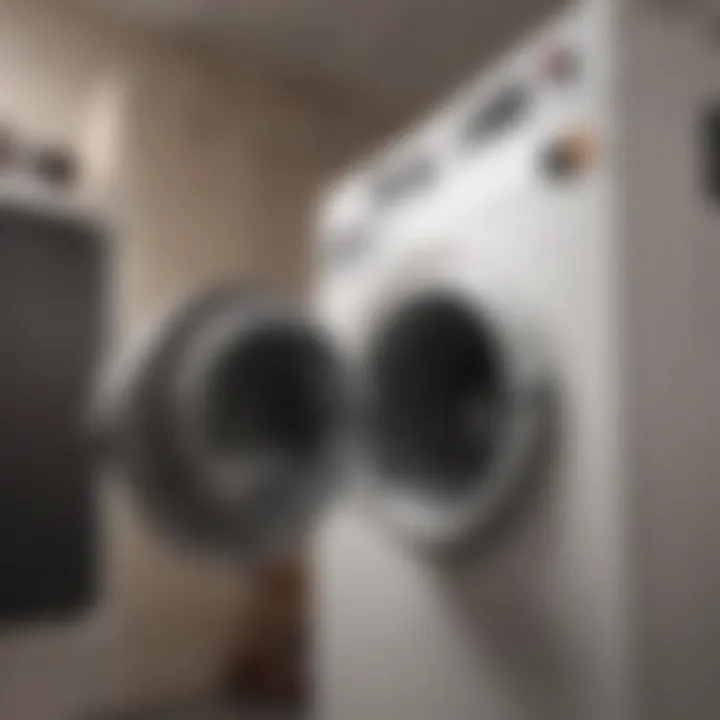A Comprehensive Guide to Cleaning a Dryer Vent


Intro
Cleaning a dryer vent is a task that often gets overlooked in home maintenance routines. However, neglecting this essential chore can lead to reduced appliance efficiency and pose serious fire risks. The buildup of lint in dryer vents can cause extended drying times, increase energy costs, and ultimately lead to dangerous situations. This guide aims to provide a clear and practical resource for homeowners who wish to ensure that their dryers function safely and effectively.
In this article, we will cover various aspects of dryer vent cleaning, from identifying the signs of lint buildup to detailing the tools necessary for the cleaning process. We will also touch upon safety measures that should be adopted and explain when it is advisable to engage professional services for more thorough cleaning. By equipping readers with the right knowledge, we hope to promote safe and efficient laundry practices.
Understanding Dryer Vent Cleaning
Before diving into the process, it is vital to understand why dryer vent cleaning is necessary. The dryer vent is the exhaust system that allows hot air to escape the appliance during operation. If not cleaned regularly, lint and debris can accumulate in the vent, leading to a blockage. This blockage can hinder airflow, forcing the dryer to work harder, increasing energy consumption, and raising the risk of fire hazards.
Signs of Buildup
Homeowners can easily overlook signs of lint buildup. Here is a list indicating when it might be time to inspect or clean the dryer vent:
- Clothes take longer than normal to dry.
- The dryer gets excessively hot during a cycle.
- The vent hood flap does not open properly when the dryer is running.
- A noticeable musty smell emanates from the dryer.
- The lint filter becomes full despite regular cleaning.
Recognizing these signs early can save time and reduce the risk of accidents.
Necessary Tools for Cleaning
Cleaning a dryer vent requires specific tools to perform the job effectively. Here are some common tools and materials needed:
- A vacuum cleaner with a hose attachment.
- A long-reaching dryer vent cleaning brush.
- Screwdriver set for disassembling vent components.
- A flashlight for inspecting the vent's interior.
- Safety glasses and gloves to protect during cleaning.
Having these tools at hand makes the cleaning process efficient and safe.
Step-by-Step Cleaning Instructions
Now let's outline the steps to clean the dryer vent:
- Disconnect the dryer from the power source. Always ensure the appliance is unplugged before starting any maintenance work.
- Detach the vent from the dryer. Use a screwdriver to remove any screws holding the vent in place.
- Inspect the vent. Use a flashlight to check for visible lint buildup or any other obstructions inside the vent.
- Use the vacuum. Insert the hose attachment of the vacuum to remove as much lint as possible.
- Use the cleaning brush. Insert the brush into the vent and rotate it to break up any stubborn lint clogs. Repeat this until the vent is clear.
- Reassemble the vent. Ensure all components are reattached securely before plugging the dryer back in.
- Test the dryer. Run the dryer for a short cycle to check that airflow is unobstructed.
Following this methodical approach ensures thorough cleaning, thereby enhancing the efficiency and safety of the appliance.
Safety Measures
While cleaning the dryer vent is a straightforward process, certain precautions should not be overlooked:
- Wear safety glasses and gloves to protect against dust and debris.
- Ensure adequate ventilation in the area where you are working.
- Avoid using flammable materials in conjunction with cleaning.
Failing to adopt these measures could lead to accidents or injuries during the cleaning process.
When to Call a Professional
While most homeowners can take care of dryer vent cleaning independently, there are situations that may warrant professional help. If your vent is long or complicated, or if you are unable to remove persistent clogs, hiring a professional service is advisable. These specialists have the experience and equipment required to safely and effectively handle challenging cleaning situations.
Furthermore, if you have recently moved into a new home or if your dryer has shown inconsistent performance over time, it may be beneficial to engage a professional for an initial inspection.
Remember: Regular maintenance of your dryer vent is key to safety and efficiency. Stay vigilant and proactive.
End
Prologue
Cleaning a dryer vent is a critical yet often overlooked task in home maintenance. Proper maintenance of your dryer vent plays a significant role in ensuring the safety and efficiency of your appliance. A clean vent allows your dryer to function optimally, reducing the risk of overheating and ensuring clothes dry faster.
Furthermore, lint buildup in the vent poses a serious fire hazard. According to the National Fire Protection Association, failure to clean dryer vents is one of the leading causes of home fires. This makes understanding the vent cleaning process not just a matter of efficiency, but a crucial step towards fire prevention in residential properties.
In this article, we will explore various facets of dryer vent cleaning, ranging from identifying signs of a clogged vent to providing detailed cleaning instructions. Readers will learn about the necessary tools and materials, safety precautions, and possible professional services. By equipping oneself with this knowledge, homeowners can maintain their dryers effectively, enhancing performance while ensuring safety.
The importance of this subject extends beyond just the act of cleaning. It involves a commitment to regular home maintenance practices that protect both personal property and lives. Being proactive in this aspect will provide peace of mind and enhance the overall functionality of your dryer.
Understanding Dryer Vents
Understanding dryer vents is a critical aspect of home maintenance that often goes overlooked. Many homeowners might not realize that a clean and functional dryer vent system plays a vital role in the overall safety and efficiency of their laundry appliances. Addressing this topic in detail prepares readers to make informed decisions about the upkeep of their dryer systems.
A dryer vent is essentially a duct that expels lint and moisture from the dryer to the outside of a home. This passage is crucial for the proper operation of a dryer. When the vent is functioning correctly, it allows for effective airflow, which in turn helps the dryer perform efficiently. Conversely, a clogged or improperly maintained vent can lead to a host of problems, including longer drying times, increased energy costs, and even the risk of fire.


What is a Dryer Vent?
A dryer vent is a pipe or duct that channels exhaust from a clothes dryer outside the home. It is usually made of rigid metal or flexible aluminum and connects to the back of the dryer, directing hot, moist air away from your laundry area. The primary function of the dryer vent is to remove the byproducts of drying clothes, such as lint and water vapor, effectively preventing moisture buildup and maintaining proper airflow.
It is important to understand that all dryers come with a vent system. However, the design and layout can differ based on the model and installation site. Many homeowners also might not be aware of the degree to which lint can accumulate in these vents over time. Routine inspection of the vent can reveal hidden issues and ensure that it remains in optimal condition, so your dryer operates effectively.
The Importance of a Clean Vent
Keeping the dryer vent clean is not just about convenience; it's a matter of safety and efficiency. A clean vent helps prevent lint buildup, which is a significant cause of dryer fires. According to the National Fire Protection Association, failure to clean a dryer vent is one of the leading causes of home dryer fires.
Regular cleaning of a dryer vent also improves the efficiency of the dryer. When vents are clogged, the dryer must work harder to dry clothes, resulting in increased energy consumption. By maintaining a clean vent, homeowners can ensure their dryer runs optimally, leading to lower utility bills and longer appliance life.
In summary, understanding the role and care of dryer vents is essential for maintaining a safe and efficient home. Simple, routine maintenance can protect against potential hazards and keep your dryer performing at its best. Taking the time to explore this often-neglected aspect of household management can lead to substantial benefits for both safety and economy.
Signs of a Clogged Dryer Vent
Recognizing when a dryer vent is clogged is essential for maintaining the longevity and efficiency of your appliance. A clear vent allows for proper airflow, enabling the dryer to operate at full capacity. Conversely, a clogged vent can lead to several problems, particularly concerning safety and functionality. By understanding the signs of buildup, homeowners can take timely action to prevent more severe issues.
Common Symptoms
Several noticeable signs can indicate a dryer vent is clogged. Here are the key symptoms:
- Longer Drying Times: If laundry takes longer than usual to dry, that may indicate that hot air is not being expelled effectively.
- Excessive Heat: A dryer that feels unusually hot to the touch may indicate that airflow is restricted. This can also cause your laundry to feel hot to the touch at the end of the cycle.
- Burning Smell: Any unusual odor, especially a burning smell, should be addressed immediately. It could suggest that lint is accumulating and poses a fire hazard.
- Lint Accumulation: If lint gathers around the dryer or inside the vent, this visible buildup may signal that cleaning is necessary.
- Moisture in the Laundry Room: Excess humidity or moisture in your laundry area can stem from a dryer that is not venting correctly.
Addressing these symptoms promptly can help maintain appliance efficiency and reduce dangers associated with excessive lint buildup.
Potential Risks
Ignoring the symptoms of a clogged dryer vent can lead to several potential risks, which can have dire consequences:
- Fire Hazard: Lint accumulation is a leading cause of dryer fires. According to reports, failing to clean the dryer vent is responsible for many home fires each year.
- Appliance Damage: Overheating caused by blocked airflow can lead to damage that may require costly repairs or the purchase of a new dryer altogether.
- Increased Energy Costs: A dryer that works harder due to airflow restrictions typically results in higher energy consumption. In the long run, this can lead to significant increases in utility bills.
- Mildew and Mold Growth: Excess moisture from a poorly ventilated dryer can create an environment conducive to mildew and mold, posing health risks to occupants.
Ignoring these signs can lead to serious implications. Regular maintenance is essential to avoid complications and ensure a safe drying environment.
Tools and Materials Needed
In the realm of maintaining a dryer vent, having the right tools and materials is crucial. These items not only streamline the cleaning process but also ensure that the task is completed efficiently and safely. Proper equipment reduces the risk of damaging the dryer or vent, which can result in expensive repairs or even replacement. Moreover, using the right tools can significantly enhance airflow, which directly impacts the efficiency of the dryer. Therefore, understanding these tools and materials is paramount for any homeowner.
Basic Cleaning Tools
To start, a few essential cleaning tools should always be on hand. Here’s a concise list of what you need:
- Dryer Vent Cleaning Kit: This typically includes a dryer brush and flexible rods. The brush removes lint and debris.
- Vacuum Cleaner with Hose Attachments: A vacuum helps to suck out loosened lint from vents and ductwork. Make sure it has strong suction capability.
- Cordless Drill: Useful if you need to remove any vent covers or access points.
- Duct Tape: This is handy for resealing duct joints that may come apart during cleaning. It is durable and can withstand different temperatures.
- Ladder: Depending on your dryer vent's location, a ladder might be necessary to reach higher vent exits or roofs.
Having these items ensures that cleaning the dryer vent is efficient and thorough. In certain situations, getting additional tools may provide better access to specific areas.
Safety Gear
Safety should never be overlooked during the cleaning process. Using safety gear helps prevent injuries and ensures that you can perform the task without unnecessary risks. Consider the following:
- Safety Goggles: Protect your eyes from dust and debris that may fly up during cleaning.
- Work Gloves: These provide grip and protect your hands from sharp or rough edges.
- Dust Mask or Respirator: This is important, especially for individuals with allergies. It can help prevent inhaling fine dust particles similar to those found in dryer vents.
- Knee Pads: If you're working on your hands and knees, knee pads can add comfort and protect your joints.
By preparing yourself with appropriate safety measures, you reduce the likelihood of accidents, making the cleaning process not only effective but also secure.
"Preparation is key to executing an effective cleaning strategy that minimizes risk and maximizes results."
Together, these tools and safety measures create a solid foundation for addressing dryer vent cleaning. The right approach leads to improved performance and longevity, directly correlating with appliance efficiency.
Preparing for Cleaning
Preparing for cleaning the dryer vent is a critical stage in the process of maintaining appliance efficiency and safety. Ensuring that you take the right steps before you begin will help you avoid potential hazards and enhance the overall effectiveness of the cleaning. Proper preparation not only guards against injury but also ensures that there are no delays during the actual cleaning.
First, disconnecting your dryer from the power supply is fundamental. This avoids any possibility of accidental activation while working on it. Second, accessing the vent should be clear and free of obstructions. This involves understanding the layout of your dryer vent system, as most houses will have different paths depending on installation. Therefore, knowing how to access critical components of the vent is where this stage becomes crucial.
Disconnecting the Dryer
To begin the disconnecting process, first locate the power cord of your dryer.
Unplugging the dryer is the simplest yet most effective action. If you are using a gas dryer, you must also shut off the gas supply. This is usually done by locating the gas shutoff valve near the back of the machine.


Once the dryer is disconnected, it’s wise to move the appliance away from the wall. This allows easier access to the venting system and makes the physical cleaning process simpler. Just remember that before you pull the dryer away from the wall, it may be helpful to have a helper, because some dryers can be quite heavy.
In short, disconnecting the dryer involves basic procedures that, when done correctly, will provide a safety buffer as you proceed. Remember to check the surrounding areas for any obstacles that might impede your progress.
Accessing the Vent
After the dryer is safely disconnected, the next step involves accessing the vent.
Begin by gently pulling the dryer away from the wall to expose the venting duct. The vent might be secured with clamps or screws, which you will need to loosen carefully depending on the specific model of your dryer.
Once you have access to the duct, it is essential to inspect it for any visible signs of lint buildup or damage. If you observe any significant accumulation, it’s an indicator that regular maintenance is long overdue. This is also an opportunity to eliminate any bends in the duct, as sharp turns can cause lint to collect more easily and restrict airflow.
In some instances, you may need to detach the duct entirely, especially if it has extensive lint buildup.
Being meticulous at this point can minimize the likelihood of future issues.
"Regular maintenance of your dryer vent is not just necessary for efficiency but a vital safety measure to prevent fire hazards."
Once you have accessed the vent, ensure that you are ready for the actual cleaning process. This preparation lays the groundwork for effective maintenance, which will lead to optimal appliance performance for the long run.
Step-by-Step Cleaning Process
Cleaning a dryer vent is a crucial task that ensures the appliance operates efficiently and safely. Many homeowners overlook this process, but understanding how to clean the dryer vent properly is important not only for appliance longevity but also for preventing fire hazards. A step-by-step approach helps demystify the cleaning process and makes it manageable. Each step contributes not just to cleanliness, but also to the overall function of the dryer, ensuring optimal airflow and reducing energy costs.
Vacuum the Vent
Begin by vacuuming the vent to remove loose lint and debris. This initial step is vital as it clears much of the buildup that can restrict airflow. Using a vacuum equipped with a long hose attachment allows you to reach deep into the ductwork. If possible, detach the vent from the dryer to vacuum it thoroughly. Be careful while handling connections, as they may be somewhat frail.
A few advantages of this step include:
- Enhanced efficiency: A cleaner vent ensures the dryer doesn't have to work harder, thus saving energy.
- Fire prevention: Removing lint reduces the risk of it catching fire.
Brush the Vent Duct
Once you've vacuume, the next step is to brush the vent duct to dislodge any stubborn lint clumps clinging to the walls of the pipe. Using a dryer vent brush, which has a long handle and bristles, is the most effective method. Insert the brush into the vent, pushing it gently while rotating it to capture lint.
Regularly brushing the duct offers many benefits:
- Maintain airflow: Ensuring a smooth passage for air leads to better drying performance.
- Prevent future clogs: Removing residue now can reduce the frequency of future cleanings.
Inspect the Exterior Vent Cap
The exterior vent cap should not be overlooked. Inspecting this component ensures that it is free from blockages and is functioning correctly. Look for any signs of lint accumulation or debris obstructing the cap. Cleaning this area is straightforward; simply remove any buildup with your hand or a soft cloth.
Key points to focus on include:
- Proper opening: Make sure the flaps of the vent cap open and close freely to prevent backflow of air.
- Check screen: If your vent cap has a lint screen, it needs regular cleaning to maintain efficiency.
Keeping your dryer vent clean is not just about convenience; it is essential for safety and appliance health.
Post-Cleaning Checks
After cleaning the dryer vent, it is essential to carry out some post-cleaning checks. These checks confirm that the drying system works efficiently and safely. Ensuring that the dryer is reconnected properly and functional can prevent problems that might arise in the future.
Reconnecting the Dryer
Once the cleaning process is complete, reconnecting the dryer is the next step. Take care to ensure that the dryer is plugged back into the electrical outlet properly. Check the connections of the vent to make sure it fits securely. A loose connection can lead to airflow issues which can reduce the efficiency of the dryer.
It's also wise to check the position of the dryer. Keep it as close to the wall as possible but ensure it is not crumpling the vent material. A good position can help maintain airflow and avoid future clogs.
Testing Functionality
Testing the functionality of the dryer is a crucial step. After reconnecting, run a test cycle to monitor how the machine performs. Observe how well the dryer heats up and whether it helps in drying clothes effectively. Look out for signs of overheating or unusual noises, as these can indicate a problem.
Make sure to check whether lint is still escaping the vent. A significant amount of lint escaping may indicate that cleaning was not thorough enough or the vent is still partially blocked.
"Routine maintenance ensures longer life and better performance for your appliances."
To summarize, both reconnecting the dryer and testing its functionality are integral to safety and performance. They contribute to efficiency while minimizing risks associated with a clogged or incorrectly positioned vent.
Frequency of Cleaning


Understanding how often to clean your dryer vent can significantly impact the efficiency of your appliance and your home's safety. With regular cleaning, you can extend the lifespan of your dryer, reduce energy costs, and minimize fire hazards. Proper air circulation is crucial for dryers. If the vent is blocked, hot air accumulates, which can lead to overheating. Over time, lint buildup can occur in ducts, making it vital to establish a cleaning schedule.
Recommended Schedule
The frequency of cleaning your dryer vent depends on several factors. A general rule of thumb is to clean the vent at least once a year. However, this can vary based on usage and the type of dryer you own. Here are some considerations:
- Usage: If your household uses the dryer frequently, consider cleaning the vent every six months. High usage can lead to faster lint accumulation.
- Dryer Type: Certain dryers, like those that use gas, may need more attention compared to electric dryers, especially if they are used daily.
- Length of Duct: Longer ducts may require more frequent cleaning since lint can collect at various points along the way.
- Household Size: Larger families with more laundry will create more lint, prompting the need for more regular maintenance.
Signs That Cleaning is Needed
While it's essential to follow a cleaning schedule, specific signs can help you determine when cleaning is crucial between scheduled maintenance. These include:
- Reduced Drying Efficiency: If clothes are taking longer than usual to dry, this may indicate a blockage.
- Excess Heat: If the dryer or the area around it feels unusually hot, it may signal an obstruction of airflow.
- Lint Accumulation: If you notice lint buildup around the lint trap or the vent opening, it is time for cleaning.
- Burning Smell: A burning scent during operation is a severe sign that immediate attention is necessary.
Regular inspection and maintenance of your dryer vent can prevent many of these issues. By staying vigilant and responsive, you safeguard your home and ensure that your dryer operates effectively.
When to Seek Professional Help
When it comes to cleaning a dryer vent, some issues are straightforward and manageable on your own. However, there are circumstances where enlisting the help of a professional is more than a convenience; it's a necessity. Recognizing when to call for expert assistance can save you time, reduce safety risks, and ensure your dryer functions efficiently.
Identifying Complex Issues
Several indicators suggest problems beyond regular maintenance. If your dryer frequently overheats, makes unusual noises, or fails to dry clothes effectively, these are signals that there may be an obstruction or damage deeper in the vent system. A buildup of lint can lead to overheating, heightening the risk of fire hazards. If the vent seems excessively long or complex—like those found in multi-story homes—it can be challenging to clean thoroughly without specialized tools.
Consider the age of your dryer and vent. Older systems may have components that degrade over time, resulting in airflow restrictions. A professional can inspect for wear and tear the average homeowner might overlook. These identifiers make it crucial to seek a qualified technician. They possess the knowledge and equipment to address unique issues that you might otherwise miss.
Choosing a Service Provider
Selecting the right service provider requires careful consideration. Not all cleaning services have the same level of expertise. Look for companies that specialize in dryer vent cleaning. It ensures they are familiar with the specific challenges associated with different vent styles. Read reviews and check credentials to verify their reliability.
Ask potential providers about their cleaning methods. A thorough cleaning involves not just clearing lint but also inspecting and possibly repairing any damage. Ensure they are willing to provide a detailed explanation of the service process. Take recommendations from friends or family. Personal experiences often provide the best insight.
Remember to inquire about safety protocols. Proper insurance and bonding protect you from liability should an accident happen during the cleaning process.
"Investing in a qualified service provider saves time and reduces risks associated with improper cleaning."
In summary, while some dryer vent maintenance tasks can be performed independently, recognizing when complex issues arise is vital. A knowledgeable and trustworthy professional can manage these challenges, restoring your dryer to optimal performance. If unsure, it is always best to err on the side of caution and look for assistance.
Additional Maintenance Tips
In order to maintain the efficiency and safety of your dryer, it is crucial to incorporate additional maintenance tips. Beyond the initial cleaning, regular upkeep ensures that the dryer operates smoothly, minimizes unnecessary wear, and extends its lifespan. Ignoring these maintenance aspects could lead to various issues, prompting more frequent repairs and increased energy bills. Below, we explore two significant areas of ongoing maintenance: regular inspections and potential upgrades.
Regular Inspections
Regular inspections of the dryer vent system should be a routine part of your home maintenance schedule. This process involves checking the vent for obstructions, wear, and staging. Inspecting the dryer vent every six months is advisable, especially if you notice any change in the performance of your dryer.
During an inspection, pay close attention to:
- Vent Duct Condition: Look for signs of damage or discoloration in the duct material. Any kinks or visible tears will impede airflow and can cause further issues.
- Lint Accumulation: Lint traps can fill quickly, and lint may escape into the ductwork. Remove lint collected at the trap, but also check the duct itself. Flush out any lint that may be trapped.
- Airflow Testing: After cleaning, ensure the airflow from the exterior vent is strong. A weak airflow may signal a blockage deeper within the system.
Inspecting your dryer vent regularly helps in identifying small issues before they escalate, ultimately saving you time and money.
Upgrades to Consider
Upgrading dryer vent materials and components can enhance the efficiency of your system significantly. When considering improvements, several factors can be evaluated:
- Transition Ducts: Consider replacing flexible ducts with rigid metal ducts. Rigid ducts allow for better airflow and are less likely to trap lint.
- Vent Hoods: Install dryer vent hoods that contain flaps preventing backdrafts when the dryer is not in use. These can reduce the risk of bird or insect obstruction.
- Lint Trap Enhancements: Upgrading to a more effective lint trap can minimize lint buildup in the duct. Some models include cleaning indicators, indicating when they require attention.
By focusing on regular inspections and appropriate upgrades, you can guarantee a functional dryer system, safeguarding your household from hazards while maximizing efficiency. Simple yet significant steps can make all the difference in dryer performance.
The End
In summary, cleaning a dryer vent is a critical process that should never be overlooked. The effectiveness of a dryer relies heavily on unobstructed airflow, and a clean vent plays an essential role in this. Not only does it enhance the performance of the appliance, but it also ensures safety by reducing fire risks associated with lint buildup.
The importance of routine maintenance cannot be emphasized enough. Regular cleaning helps prolong the life of your dryer, making it more efficient and energy-saving. It also minimizes the wear and tear on the appliance, allowing it to operate smoothly for years. Homeowners may not realize that neglecting this task can lead to costly repairs or replacements.
Here are some specific elements to consider while concluding this article:
- Safety: A clean dryer vent greatly reduces the chances of fire hazards. Given that lint is highly flammable, ensuring the vent is free from blockages is vital for protection.
- Efficiency: Improved airflow not only shortens drying times but can also lead to lower energy bills. This efficiency benefits both the environment and your finances.
- Maintenance Routine: Setting a schedule for cleaning dryer vents can help prevent the buildup of lint and debris. This proactive approach is more effective than dealing with problems as they arise.
In essence, understanding the process and making cleaning a priority can vastly improve safety and efficiency in your home. Keeping your dryer vent clean is not just about appliance upkeep; it is about safeguarding your home and enhancing your overall quality of life.
"Routine maintenance is not an expense; it is an investment in your safety and efficiency."
By incorporating the steps and tips discussed in this article, you will ensure your dryer operates effectively, contributing to a safer environment in your home.















